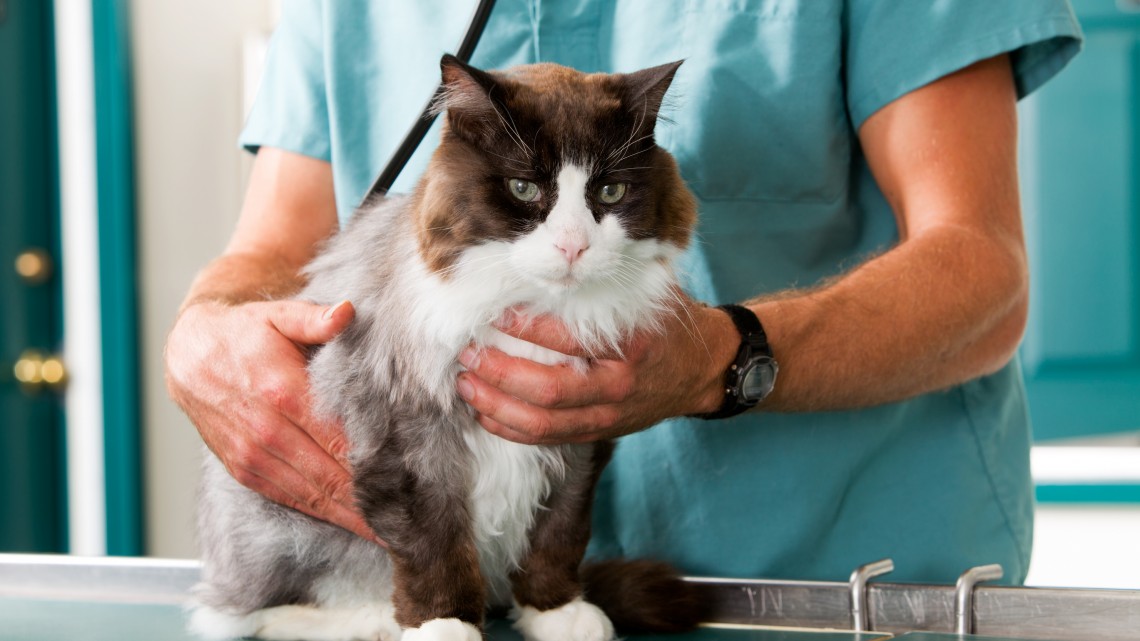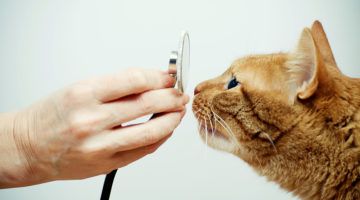Cats are good at hiding discomfort when they’re not feeling well. It’s important to recognize the subtle signs of illness so you’ll know when a trip to the vet is in order.
When a dog is sick, you know it. Unfortunately, the same is not always true with cats. Kitties are masters at hiding signs of illness when they don’t feel good. In fact your cat may not appear ill at all until he’s very sick. So how do you know when you should be concerned? When should you take him to the veterinarian?
Tortoise or hare?
Most cats move pretty quickly when encouraged to do so. If your cat is normally playful and active and always comes when you open his can of food – but is suddenly nowhere to be found as you prepare his breakfast, chances are he’s not feeling too good.
Veterinarians commonly see cats with vague signs of illness such as anorexia and lethargy (a condition we abbreviate as “A&L”). These cats are also called ADR, which stands for “ain’t doin’ right”. Regardless of the actual cause, any cat that doesn’t feel good could present with lack of interest in food and a decreased activity level. Because these signs are vague and can occur with numerous diseases, from minor to serious, it’s important for your cat to be seen by a vet as soon as you notice something amiss. Generally speaking, a full battery of lab tests including blood and urine testing and sometimes radiographs and ultrasounds will need to be done to discover the cause.
Unlike dogs or humans, cats that don’t eat for 48 to 72 hours can develop a potentially fatal liver disease called hepatic lipidosis (fatty liver disease). For this reason, cats that exhibit decreased appetite and lethargy should be seen within one to two days of developing clinical signs.
The most common diagnosis for what appears to be a “constipated cat” is feline lower urinary tract disorder (FLUTD).
Vocal cues
Most cat people come to enjoy their felines’ purrs, meows and other vocalizations. But what if your cat’s voice suddenly changes? What if he no longer meows or talks to you? Conversely, what if he starts crying a lot more than normal? While not specific to any particular disease, any change in vocalization could indicate a serious illness and indicates a trip to the doctor.
Red Flags
A change in your cat’s normal behavior is cause for concern, but here are some signs he could be sick and should see a vet.
- Eating less, eating more, or not eating at all
- Drinking less, drinking more, or not drinking at all
- Has difficulty moving or is unable to move
- Not as playful as usual
- Hiding in the house
- Spending too much time in the litterbox
- Not vocalizing as much, vocalizing too much, or not vocalizing at all
Signs of arthritis
Cats get arthritis as often as dogs. Unfortunately, many cat families and veterinarians don’t suspect arthritic pain as the cause of a kitty’s current medical problem. While many signs can be seen in cats suffering from arthritis, here’s a common problems I see in my practice that make me think of arthritis as a possible diagnosis.
Let’s suppose your beloved feline stops using his litterbox and instead begins eliminating on the floor. It may be that it has become too painful for him to climb in and out of the box. He might be incorrectly diagnosed as having urinary tract problems or behavior issues. With the correct diagnosis of arthritis, simply treating the pain would solve the inappropriate elimination. Cats with arthritis also may not want to jump on and off furniture or be as playful as in prior years.
Many joint supplements, herbs, homeopathics and even conventional medications can help arthritic cats feel much more comfortable. The only caution is that cats have trouble detoxifying many drugs. Commonly used anti-arthritic medications like NSAIDs must be used very carefully and infrequently to prevent toxicity.
“My cat’s constipated”
I hear this complaint all the time. But you know what? I rarely see constipation in cats. Usually, if a cat seems constipated, especially if it’s a male spending a lot of time in the litterbox, it’s something more serious. The most common diagnosis for what appears to be a “constipated cat” is feline lower urinary tract disorder (FLUTD).
A cat that can’t urinate properly is a medical emergency. Cats suspected of being constipated should be seen by a veterinarian as soon as possible. If the cat is truly constipated, which as I mentioned is very rare, simply sedating him and giving him an enema will solve the problem. For cats that turn out to have a urinary tract obstruction, sedation and removal of the obstruction via urinary catheterization is a lifesaving maneuver.
Cats often hide signs of illness, even serious illness, until late in the course of the disease. Remembering this rule will always favor your cat. If he acts in any way that seems even subtly abnormal, it’s time for a checkup!







I am actually grateful tto the owner of this web page who has shared
this great post at at this time.